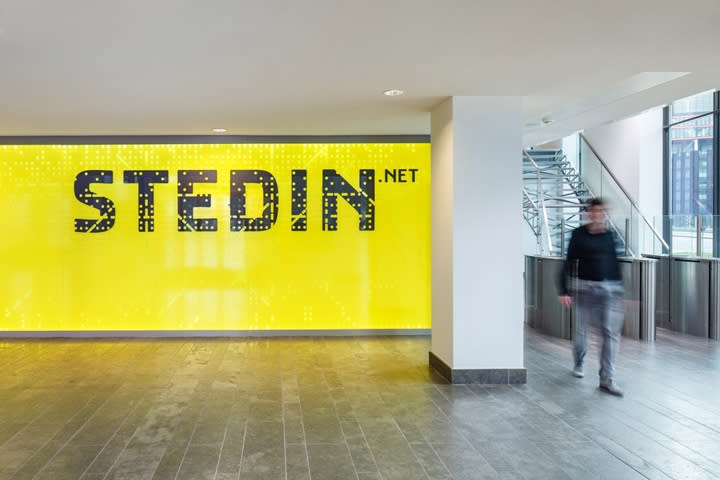Agile in progress: Why wellbeing and inclusivity are the new success factors

A few weeks ago I had the chance to take a look behind the scenes at Stedin, one of the largest grid operators in the Netherlands. With a view over the Rotterdam skyline, the office itself was already impressive. But what struck me even more was their focus. Accelerating the energy transition while reliably providing electricity to millions of households and businesses. And they do this with scalable agile ways of working (SAFe).
Yet something else left the biggest impression on me…
What really stuck with me
I see it in almost every team. There’s always someone struggling with stress, personal issues, workload, or simply the feeling of constantly having to keep up (the 3 O’s of Goodbusy). Sometimes visible, often invisible. And I’ve been there myself. So naturally, you want to prevent it. For yourself… but especially to help others too.
The 3 O’s according to Kate from The GoodBusy: Overworked, Overcommitted, Overwhelmed.
Subtle signals that a team or individual is slowly heading for collapse.
Still, many frameworks say very little about this. Scrum, SAFe… it’s all about processes, roles, and events. But psychological safety? Mental health? That’s rarely in the manual.
Maybe that’s also why my visit to Stedin stayed with me. In every team they have an RTE, a Product Manager, and a Solution Architect. Years ago, they started experimenting with adding a People Developer. Together, they form the Tactical Square.
And it was that People Developer role that suddenly gave space to the human dimension. And they’re proud of it (rightfully so). The role is fully focused on growth, collaboration, and wellbeing. Strangely enough, that feels refreshing.
It made me wonder… how many companies actually pay real attention to this?

My search for human-centered roles
My curiosity was triggered… what roles and developments around mental health and the human side do we actually see in modern agile teams?
I started with the Scrum Master and Agile Coach. In many teams still seen as process guardians. But according to the Scrum Guide, they’re above all servant leaders. Coaches who help individuals, stimulate collaboration, and remove barriers. Also in the areas of culture and wellbeing.
So we can assume a good Scrum Master definitely pays attention to this. But personally, I think this side should come out more clearly in agile training… which means there’s an opportunity here.
I also noticed that an Agile Coach sometimes takes on the title of Agile People Coach. A deliberate broadening of the role. Not just guiding processes, but also paying attention to the human side. Research from Google (Project Aristotle) shows why this matters: psychological safety is the number one factor for high-performing teams. Without it, people don’t dare to admit mistakes and ideas remain unspoken.
Then I looked at the Spotify model. Their Chapter Leads aren’t classic managers. They work hands-on in a squad, but are also responsible for the personal development of their chapter members. A hybrid role that shows coaching and growth can be a structural part of the organization.
Personally, I’m not a fan of such hybrid roles when it comes to wellbeing and personal coaching. Too often I’ve seen teams tell me their leader simply didn’t have time for them. It looks good on paper… but doesn’t work in practice.
And then I thought back to a LinkedIn post by Steven Bartlett a few months ago. He announced that his company had hired a Head of Happiness and Health. Not a fancy title for the website or personal branding. But a serious role that makes culture and wellbeing just as measurable as revenue and velocity. Happiness as a KPI. That makes it visible… and therefore discussable.
I think that’s gold. Because it’s anything but obvious. In most organizations this sits with HR, often as an “extra task.” But this is a development I fully support.
Because when a team feels good, everything works better. People stay longer. There’s less turnover. More creativity and inclusivity. Relying on gut feeling just isn’t enough when it comes to happiness at work.
The common thread
The more I looked, the clearer it became that my belief holds true. Mentally healthy teams perform more steadily. Retain talent. Build more inclusive cultures. They don’t just deliver faster… they deliver sustainably.
Because a team that knows each other inside out, and sees each other’s strengths and weaknesses, can focus on growth. Of the product… and of themselves as people.
What I’m developing
Because this topic is so important to me, I’m working on a Team Scan. A practical starting point for organizations that want to take the human side more seriously.
That scan combines at least three ingredients:
✅ Insights into work preferences for every team member.
✅ Insights into management expectations for team member roles.
✅ Insights into happiness and culture for a longer period (3, 6 or 12 months)
The goal is simple: to give teams a clear starting point. So that conversations about culture, wellbeing, and performance finally get on the table.
And it doesn’t stop there. You want team wellbeing visible in the same dashboard where you track your KPIs. Not just velocity and delivery… but also happiness at work.
In closing
I already had a strong opinion about the human side of agile. And this shows it’s not a luxury. It’s the key to steady performance and healthy, engaged teams. My visit to Stedin confirmed me this isn’t just an idea, but already happening in practice.
With my experience and my passion for the human side of agile teams, I want to play a role in this. By making wellbeing and performance discussable and measurable, together.
👉 Want to have more insights as this? Subscribe to my weekly newsletter.
Sources
The Good Busy – The 3 O’s: Overworked, Overcommitted, Overwhelmed → Check out 🔗 thegoodbusy.com
Google Re:Work – Project Aristotle: research on team effectiveness and psychological safety → Read 🔗 rework.withgoogle.com
Spotify model – Description of squads, chapters, and chapter leads → Spotify Engineering Culture – 🔗 YouTube
Steven Bartlett – LinkedIn post on hiring a Head of Happiness and Health (2025) → 🔗 Check it out
